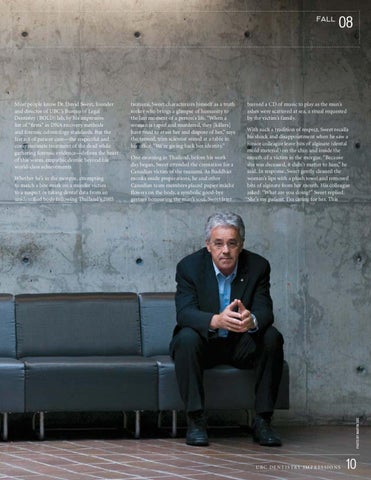>9DD
Whether he’s in the morgue, attempting to match a bite mark on a murder victim to a suspect or taking dental data from an unidentified body following Thailand’s 2005
tsunami, Sweet characterizes himself as a truth seeker who brings a glimpse of humanity to the last moment of a person’s life. “When a woman is raped and murdered, they [killers] have tried to erase her and dispose of her,” says the tanned, trim scientist seated at a table in his office. “We’re giving back her identity.” One morning in Thailand, before his work day began, Sweet attended the cremation for a Canadian victim of the tsunami. As Buddhist monks made preparations, he and other Canadian team members placed papier mâché flowers on the body, a symbolic good-bye gesture honouring the man’s soul. Sweet later
burned a CD of music to play as the man’s ashes were scattered at sea, a ritual requested by the victim’s family. With such a tradition of respect, Sweet recalls his shock and disappointment when he saw a junior colleague leave bits of alginate (dental mold material) on the chin and inside the mouth of a victim in the morgue. “Because she was deceased, it didn’t matter to him,” he said. In response, Sweet gently cleaned the woman’s lips with a plush towel and removed bits of alginate from her mouth. His colleague asked: “What are you doing?” Sweet replied: “She’s my patient. I’m caring for her. This
PHOTO BY MARTIN DEE
Most people know Dr. David Sweet, founder and director of UBC’s Bureau of Legal Dentistry (BOLD) lab, by his impressive list of “firsts” in DNA recovery methods and forensic odontology standards. But the last act of patient care—the respectful and compassionate treatment of the dead while gathering forensic evidence—defines the heart of this warm, empathic dentist beyond his world-class achievements.
08
U B C D E N T I S T RY I M P R E S S I O N S
10
